Enhancement of the Modulation Response of Quantum-Dot-Based Down-Converted Light through Surface Plasmon Coupling
Abstract
:1. Introduction
2. Surface Plasmon Coupling for Enhancing Modulation Response
2.1. Fundamentals of Surface Plasmon Coupling
2.2. Modulation Response Enhancement of a Light-Emitting Diode through SP Coupling
2.3. Modulation Response in Photon Down-Conversion
3. Experimental Demonstrations
3.1. Device Structures and Fabrication Procedures
3.2. Device Characterization Results
3.3. Discussions
4. Conclusions
Author Contributions
Funding
Institutional Review Board Statement
Informed Consent Statement
Data Availability Statement
Conflicts of Interest
References
- Yu, L.; Wang, L.; Hao, Z.; Luo, Y.; Sun, C.; Xiong, B.; Han, Y.; Wang, J.; Li, H. High-speed micro-LEDs for visible light communication: Challenges and progresses. Semicond. Sci. Technol. 2022, 37, 023001. [Google Scholar] [CrossRef]
- Ren, A.; Wang, H.; Zhang, W.; Wu, J.; Wang, Z.; Penty, R.V.; White, I.H. Emerging light-emitting diodes for next-generation data communications. Nat. Electron. 2021, 4, 559–572. [Google Scholar] [CrossRef]
- Karunatilaka, D.; Zafar, F.; Kalavally, V.; Parthiban, R. LED based indoor visible light communications: State of the art. IEEE Commun. Surv. Tutor. 2015, 17, 1649–1678. [Google Scholar] [CrossRef]
- Almadani, Y.; Plets, D.; Bastiaens, S.; Joseph, W.; Ijaz, M.; Ghassemlooy, Z.; Rajbhandari, S. Visible light communications for industrial applications—Challenges and potentials. Electronics 2020, 9, 2157. [Google Scholar] [CrossRef]
- Wan, R.; Wang, L.; Huang, J.; Yi, X.; Kuo, H.C.; Li, J. Improving the modulation bandwidth of GaN-based light-emitting diodes for high-speed visible light communication: Countermeasures and challenges. Adv. Photonics Res. 2021, 2, 2100093. [Google Scholar] [CrossRef]
- Wang, L.; Wei, Z.; Chen, C.J.; Wang, L.; Fu, H.Y.; Zhang, L.; Chen, K.C.; Wu, M.C.; Dong, Y.; Hao, Z.; et al. 1.3 GHz E-O bandwidth GaN-based micro-LED for multi-gigabit visible light communication. Photon. Res. 2021, 9, 792–802. [Google Scholar] [CrossRef]
- Cao, H.; Lin, S.; Ma, Z.; Li, X.; Li, J.; Zhao, L. Color converted white light-emitting diodes with 637.6 MHz modulation bandwidth. IEEE Electron Dev. Lett. 2019, 40, 267–270. [Google Scholar] [CrossRef]
- Haggar, J.I.; Cai, Y.; Ghataora, S.S.; Smith, R.M.; Bai, J.; Wang, T. High modulation bandwidth of semipolar (11−22) InGaN/GaN LEDs with long wavelength emission. ACS Appl. Electron. Mater. 2020, 2, 2363–2368. [Google Scholar] [CrossRef]
- Monavarian, M.; Rashidi, A.; Aragon, A.A.; Oh, S.H.; Rishinaramangalam, A.K.; DenBaars, S.P.; Feezell, D. Impact of crystal orientation on the modulation bandwidth of InGaN/GaN light-emitting diodes. Appl. Phys. Lett. 2018, 112, 041104. [Google Scholar] [CrossRef]
- Rajabi, K.; Wang, J.; Jin, J.; Xing, Y.; Wang, L.; Han, Y.; Sun, C.; Hao, Z.; Luo, Y.; Qian, K.; et al. Improving modulation bandwidth of c-plane GaN-based light-emitting diodes by an ultrathin quantum wells design. Opt. Express 2018, 26, 24985–24991. [Google Scholar] [CrossRef]
- Xiao, X.; Tang, H.; Zhang, T.; Chen, W.; Chen, W.; Wu, D.; Wang, R.; Wang, K. Improving the modulation bandwidth of LED by CdSe/ZnS quantum dots for visible light communication. Opt. Express 2016, 24, 21577–21586. [Google Scholar] [CrossRef]
- Zhu, S.; Lin, S.; Li, J.; Yu, Z.; Cao, H.; Yang, C.; Li, J.; Zhao, L. Influence of quantum confined Stark effect and carrier localization effect on modulation bandwidth for GaN-based LEDs. Appl. Phys. Lett. 2017, 111, 171105. [Google Scholar] [CrossRef]
- Huang, Y.; Guo, Z.; Huang, H.; Sun, H. Influence of current density and capacitance on the bandwidth of VLC LED. IEEE Photon. Technol. Lett. 2018, 30, 773–776. [Google Scholar] [CrossRef]
- Shambat, G.; Ellis, B.; Majumdar, A.; Petykiewicz, J.; Mayer, M.A.; Sarmiento, T.; Harris, J.; Haller, E.E.; Vuckovic, J. Ultrafast direct modulation of a single-mode photonic crystal nanocavity light-emitting diode. Nat. Comm. 2011, 2, 539. [Google Scholar] [CrossRef] [PubMed] [Green Version]
- Oh, J.H.; Lee, K.H.; Yoon, H.C.; Yang, H.; Do, Y.R. Color-by-blue display using blue quantum dot light-emitting diodes and green/red color converting phosphors. Opt. Express 2014, 22, A511–A520. [Google Scholar] [CrossRef]
- Han, H.V.; Lin, H.Y.; Lin, C.C.; Chong, W.C.; Li, J.R.; Chen, K.J.; Yu, P.; Chen, T.M.; Chen, H.M.; Lau, K.M.; et al. Resonant-enhanced full-color emission of quantum-dot-based micro LED display technology. Opt. Express 2015, 23, 32504–32515. [Google Scholar] [CrossRef] [PubMed]
- Jang, E.; Jun, S.; Jang, H.; Lim, J.; Kim, B.; Kim, Y. White-light-emitting diodes with quantum dot color converters for display backlights. Adv. Mater. 2010, 22, 3076–3080. [Google Scholar] [CrossRef]
- Ferrari, L.; Smalley, J.S.T.; Qian, H.; Tanaka, A.; Lu, D.; Dayeh, S.; Fainman, Y.; Liu, Z. Design and analysis of blue InGaN/GaN plasmonic LED for high-speed, high-efficiency optical communications. ACS Photon. 2018, 5, 3557–3564. [Google Scholar] [CrossRef]
- Park, H.C.; Isnaeni; Gong, S.; Cho, Y.H. How effective is plasmonic enhancement of colloidal quantum dots for color-conversion light-emitting devices? Small 2017, 13, 1701805. [Google Scholar] [CrossRef]
- Wan, R.; Li, G.; Gao, X.; Liu, Z.; Li, J.; Yi, X.; Chi, N.; Wang, L. Nanohole array structured GaN-based white LEDs with improved modulation bandwidth via plasmon resonance and non-radiative energy transfer. Photon. Res. 2021, 9, 1213–1217. [Google Scholar] [CrossRef]
- Wan, R.; Zhang, S.; Liu, Z.; Yi, X.; Wang, L.; Wang, J.; Li, J.; Zhu, W.; Li, J. Simultaneously improve the luminous efficiency and color-rendering index of GaN-based white-light-emitting diodes using metal localized surface plasmon resonance. Opt. Lett. 2019, 44, 4155–4158. [Google Scholar] [CrossRef] [PubMed]
- Zhu, S.C.; Yu, Z.G.; Zhao, L.X.; Wang, J.X.; Li, J.M. Enhancement of the modulation bandwidth for GaN-based light-emitting diode by surface plasmons. Opt. Express 2015, 23, 13752–13760. [Google Scholar] [CrossRef] [PubMed]
- Yang, C.; Bettiol, A.A.; Shi, Y.; Bosman, M.; Tan, H.R.; Goh, W.P.; Teng, J.H.; Teo, E.J. Fast electrical modulation in a plasmonic-enhanced, V-pit-textured, light-emitting diode. Adv. Opt. Mater. 2015, 3, 1703–1709. [Google Scholar] [CrossRef]
- Chang, C.Y.; Yu, C.L.; Lin, C.A.; Lin, H.T.; Lee, A.B.; Chen, Z.Z.; Lu, L.S.; Chang, W.H.; Kuo, H.C.; Shih, M.H. Hybrid composites of quantum dots, monolayer WSe2, and Ag nanodisks for white light-emitting diodes. ACS Appl. Nano Mater. 2020, 3, 6855–6862. [Google Scholar] [CrossRef]
- Zhuang, Z.; Li, C.; Zhang, Y.; Liu, B.; Zhang, X.; Fan, A.; Chen, S.; Lu, L.; Cui, Y. Influence of plasmonic resonant wavelength on energy transfer from an InGaN quantum well to quantum dots. Appl. Phys. Lett. 2021, 118, 202103. [Google Scholar] [CrossRef]
- Murphy, G.P.; Gough, J.J.; Higgins, L.J.; Karanikolas, V.D.; Wilson, K.M.; Garcia Coindreau, J.A.; Zubialevich, V.Z.; Parbrook, P.J.; Bradley, A.L. Ag colloids and arrays for plasmonic nonradiative energy transfer from quantum dots to a quantum well. Nanotechnology 2017, 28, 115401. [Google Scholar] [CrossRef] [Green Version]
- Guo, S.; Li, X.; Xie, R.; Li, Z. Bandwidth enhancement for GaN-based light-emitting diode by periodic Ag nanopillar arrays and diamond arrays. J. Mater. Sci. Mater. Electron. 2021, 32, 2448–2458. [Google Scholar] [CrossRef]
- Maier, S.A. Plasmonics: Fundamentals and Applications; Springer: New York, NY, USA, 2007. [Google Scholar]
- Chikkaraddy, R.; De Nijs, B.; Benz, F.; Barrow, S.J.; Scherman, O.A.; Rosta, E.; Demetriadou, A.; Fox, P.; Hess, O.; Baumberg, J.J. Single-molecule strong coupling at room temperature in plasmonic nanocavities. Nature 2016, 535, 127–130. [Google Scholar] [CrossRef] [Green Version]
- Förster, T. Energy transport and fluorescence. Naturwissenschaften 1946, 33, 166–175. [Google Scholar]
- Purcell, E.M. Spontaneous emission probabilities at radio frequencies. Phys. Rev. 1946, 69, 681. [Google Scholar]
- Kuo, Y.; Lin, C.H.; Chen, H.S.; Hsieh, C.; Tu, C.G.; Shih, P.Y.; Chen, C.H.; Liao, C.H.; Su, C.Y.; Yao, Y.F.; et al. Surface plasmon coupled light-emitting diode—Experimental and numerical studies. Jpn. Appl. Phys. 2015, 54, 02BD01. [Google Scholar] [CrossRef]
- Yeh, D.M.; Huang, C.F.; Chen, C.Y.; Lu, Y.C.; Yang, C.C. Surface plasmon coupling effect in an InGaN/GaN single-quantum-well light-emitting diode. Appl. Phys. Lett. 2007, 91, 171103. [Google Scholar] [CrossRef] [Green Version]
- Lu, Y.C.; Cheng, C.Y.; Shen, K.C.; Yang, C.C. Enhanced photoluminescence excitation in surface plasmon coupling with an InGaN/GaN quantum well. Appl. Phys. Lett. 2007, 91, 183107. [Google Scholar] [CrossRef]
- Yeh, D.M.; Huang, C.F.; Chen, C.Y.; Lu, Y.C.; Yang, C.C. Localized surface plasmon-induced emission enhancement of a green light-emitting diode. Nanotechnology 2008, 19, 345201. [Google Scholar] [CrossRef] [Green Version]
- Kuo, Y.; Ting, S.Y.; Liao, C.H.; Huang, J.J.; Chen, C.Y.; Hsieh, C.; Lu, Y.C.; Chen, C.Y.; Shen, K.C.; Lu, C.F.; et al. Surface plasmon coupling with radiating dipole for enhancing the emission efficiency of a light-emitting diode. Opt. Express 2011, 19, A914–A929. [Google Scholar] [CrossRef]
- Huang, C.W.; Tseng, H.Y.; Chen, C.Y.; Liao, C.H.; Hsieh, C.; Chen, K.Y.; Lin, H.Y.; Chen, H.S.; Jung, Y.L.; Kiang, Y.W.; et al. Fabrication of surface metal nanoparticles and their induced surface plasmon coupling with subsurface InGaN/GaN wells. Nanotechnology 2011, 22, 475201. [Google Scholar] [CrossRef]
- Kuo, Y.; Chang, W.Y.; Chen, H.S.; Kiang, Y.W.; Yang, C.C. Surface plasmon coupling with a radiating dipole near an Ag nanoparticle embedded in GaN. Appl. Phys. Lett. 2013, 102, 161103. [Google Scholar] [CrossRef]
- Kuo, Y.; Chen, H.T.; Chang, W.Y.; Chen, H.S.; Yang, C.C.; Kiang, Y.W. Enhancements of the emission and light extraction of a radiating dipole coupled with localized surface plasmon induced on a surface metal nanoparticle in a light-emitting device. Opt. Express 2014, 22, A155–A166. [Google Scholar] [CrossRef]
- Lin, C.H.; Hsieh, C.; Tu, C.G.; Kuo, Y.; Chen, H.S.; Shih, P.Y.; Liao, C.H.; Kiang, Y.W.; Yang, C.C.; Lai, C.H.; et al. Efficiency improvement of a vertical light-emitting diode through surface plasmon coupling and grating scattering. Opt. Express 2014, 22, A842–A856. [Google Scholar] [CrossRef]
- Lin, C.H.; Tu, C.G.; Yao, Y.F.; Chen, S.H.; Su, C.Y.; Chen, H.T.; Kiang, Y.W.; Yang, C.C. High modulation bandwidth of a light-emitting diode with surface plasmon coupling. IEEE Transact. Electron Dev. 2016, 63, 3989–3995. [Google Scholar] [CrossRef]
- Lin, C.H.; Su, C.Y.; Zhu, E.; Yao, Y.F.; Hsieh, C.; Tu, C.G.; Chen, H.T.; Kiang, Y.W.; Yang, C.C. Modulation behaviors of surface plasmon coupled light-emitting diode. Opt. Express 2015, 23, 8150–8161. [Google Scholar] [CrossRef] [PubMed]
- Lin, C.H.; Chen, C.H.; Yao, Y.F.; Su, C.Y.; Shih, P.Y.; Chen, H.S.; Hsieh, C.; Kuo, Y.; Kiang, Y.W.; Yang, C.C. Behaviors of surface plasmon coupled light-emitting diodes induced by surface Ag nanoparticles on dielectric interlayers. Plasmonics 2015, 10, 1029–1040. [Google Scholar] [CrossRef]
- Lu, C.F.; Liao, C.H.; Chen, C.Y.; Hsieh, C.; Kiang, Y.W.; Yang, C.C. Reduction in the efficiency droop effect of a light-emitting diode through surface plasmon coupling. Appl. Phys. Lett. 2010, 96, 261104. [Google Scholar] [CrossRef]
- Lin, C.H.; Su, C.Y.; Kuo, Y.; Chen, C.H.; Yao, Y.F.; Shih, P.Y.; Chen, H.S.; Hsieh, C.; Kiang, Y.W.; Yang, C.C. Further reduction of efficiency droop effect by adding a lower-index dielectric interlayer in a surface plasmon coupled blue light-emitting diode with surface metal nanoparticles. Appl. Phys. Lett. 2014, 105, 101106. [Google Scholar] [CrossRef]
- Kuo, Y.; Chang, W.Y.; Lin, C.H.; Yang, C.C.; Kiang, Y.W. Evaluating the blue-shift behaviors of the surface plasmon coupling of an embedded light emitter with a surface Ag nanoparticle by adding a dielectric interlayer or coating. Opt. Express 2015, 23, 30709–30720. [Google Scholar] [CrossRef]
- Yeh, D.M.; Chen, C.Y.; Lu, Y.C.; Huang, C.F.; Yang, C.C. Formation of various metal nanostructures with thermal annealing to control the effective coupling energy between a surface plasmon and an InGaN/GaN quantum well. Nanotechnology 2007, 18, 265402. [Google Scholar] [CrossRef]
- Chen, H.S.; Chen, C.P.; Kuo, Y.; Chou, W.H.; Shen, C.H.; Jung, Y.L.; Kiang, Y.W.; Yang, C.C. Surface plasmon coupled light-emitting diode with metal protrusions into p-GaN. Appl. Phys. Lett. 2013, 102, 041108. [Google Scholar] [CrossRef]
- Hsieh, C.; Yao, Y.F.; Chen, C.F.; Shih, P.Y.; Lin, C.H.; Su, C.Y.; Chen, H.S.; Chen, C.H.; Yu, C.K.; Kiang, Y.W.; et al. Localized surface plasmon coupled light-emitting diodes with buried and surface Ag nanoparticles. IEEE Photon. Technol. Lett. 2014, 26, 1699–1702. [Google Scholar] [CrossRef]
- Liu, Y.; Wang, Z.; Liu, Y.; Zhu, G.; Jacobson, O.; Fu, X.; Bai, R.; Lin, X.; Lu, N.; Yang, X.; et al. Suppressing nanoparticle-mononuclear phagocyte system interactions of two-dimensional gold nanorings for improved tumor accumulation and photothermal ablation of tumors. ACS Nano 2017, 11, 10539–10548. [Google Scholar] [CrossRef]
- Cai, C.J.; Wang, Y.T.; Ni, C.C.; Wu, R.N.; Chen, C.Y.; Kiang, Y.W.; Yang, C.C. Emission behaviors of colloidal quantum dots linked onto synthesized metal nanoparticles. Nanotechnology 2020, 31, 095201. [Google Scholar] [CrossRef]
- Lin, C.H.; Su, C.Y.; Yao, Y.F.; Su, M.Y.; Chiang, H.C.; Tsai, M.C.; Liu, W.H.; Tu, C.G.; Kiang, Y.W.; Yang, C.C.; et al. Further emission efficiency improvement of a commercial-quality light-emitting diode through surface plasmon coupling. Opt. Lett. 2018, 43, 5631–5634. [Google Scholar] [CrossRef] [PubMed]
- Su, C.Y.; Tu, C.G.; Liu, W.H.; Lin, C.H.; Yao, Y.F.; Chen, H.T.; Wu, Y.R.; Kiang, Y.W.; Yang, C.C. Enhancing the hole-injection efficiency of a light-emitting diode by increasing Mg doping in the p-AlGaN electron-blocking layer. IEEE Transact. Electron Dev. 2017, 64, 3226–3233. [Google Scholar] [CrossRef]
- Su, C.Y.; Lin, C.H.; Yao, Y.F.; Liu, W.H.; Su, M.Y.; Chiang, H.C.; Tsai, M.C.; Tu, C.G.; Chen, H.T.; Kiang, Y.W.; et al. Dependencies of surface plasmon coupling effects on the p-GaN thickness of a thin-p-type light-emitting diode. Opt. Express 2017, 25, 21526–21536. [Google Scholar] [CrossRef] [PubMed]
- Lu, Y.C.; Chen, Y.S.; Tsai, F.J.; Wang, J.Y.; Lin, C.H.; Chen, C.Y.; Kiang, Y.W.; Yang, C.C. Improving emission enhancement in surface plasmon coupling with an InGaN/GaN quantum well by inserting a dielectric layer of low refractive index between metal and semiconductor. Appl. Phys. Lett. 2009, 94, 233113. [Google Scholar] [CrossRef]
- Bhattacharya, P. Semiconductor Optoelectronic Devices; Prentice Hall International, Inc.: Hoboken, NJ, USA, 1997. [Google Scholar]
- Yeh, D.M.; Huang, C.F.; Yang, C.C. White-light light-emitting device based on surface plasmon-enhanced CdSe/ZnS nanocrystal wavelength conversion on a blue/green two-color light-emitting diode. Appl. Phys. Lett. 2008, 92, 091112. [Google Scholar] [CrossRef]
- Lin, C.H.; Chiang, H.C.; Wang, Y.T.; Yao, Y.F.; Chen, C.C.; Tse, W.F.; Wu, R.N.; Chang, W.Y.; Kuo, Y.; Kiang, Y.W.; et al. Efficiency enhancement of light color conversion through surface plasmon coupling. Opt. Express 2018, 26, 23629–23640. [Google Scholar] [CrossRef]
- Wang, Y.T.; Liu, C.W.; Chen, P.Y.; Wu, R.N.; Ni, C.C.; Cai, C.J.; Kiang, Y.W.; Yang, C.C. Color conversion efficiency enhancement of colloidal quantum dot through its linkage with synthesized metal nanoparticle on a blue light-emitting diode. Opt. Lett. 2019, 44, 5691–5694. [Google Scholar] [CrossRef]
- Chang, W.Y.; Kuo, Y.; Kiang, Y.W.; Yang, C.C. Simulation study on light color conversion enhancement through surface plasmon coupling. Opt. Express 2019, 27, A629–A642. [Google Scholar] [CrossRef]
- Wang, Y.T.; Wu, R.N.; Ni, C.C.; Lu, C.C.; Cai, C.J.; Tse, W.F.; Chang, W.Y.; Kuo, Y.; Kiang, Y.W.; Yang, C.C. Important role of surface plasmon coupling with the quantum wells in a surface plasmon enhanced color-converting structure of colloidal quantum dots on quantum wells. Opt. Express 2020, 28, 13352–13367. [Google Scholar] [CrossRef]
- Pillai, S.; Catchpole, K.R.; Trupke, T.; Green, M.A. Surface plasmon enhanced silicon solar cells. J. Appl. Phys. 2007, 101, 093105. [Google Scholar] [CrossRef]
- Atwater, H.A.; Polman, A. Plasmonics for improved photovoltaic devices. Nat. Mater. 2010, 9, 205–213. [Google Scholar] [CrossRef] [PubMed]
- Tsai, F.J.; Wang, J.Y.; Huang, J.J.; Kiang, Y.W.; Yang, C.C. Absorption enhancement of an amorphous Si solar cell through surface plasmon-induced scattering with metal nanoparticles. Opt. Express 2010, 18, A207–A220. [Google Scholar] [CrossRef] [PubMed]
- Lin, H.Y.; Kuo, Y.; Liao, C.Y.; Yang, C.C.; Kiang, Y.W. Surface plasmon effects in the absorption enhancements of amorphous silicon solar cells with periodical metal nanowall and nanopillar structures. Opt. Express 2012, 20, A104–A118. [Google Scholar] [CrossRef] [PubMed]
- Achermann, M.; Petruska, M.A.; Kos, S.; Smith, D.L.; Koleske, D.D.; Klimov, V.I. Energy-transfer pumping of semiconductor nanocrystals using an epitaxial quantum well. Nature 2004, 429, 642–646. [Google Scholar] [CrossRef]
- Chanyawadee, S.; Lagoudakis, P.G.; Harley, R.T.; Charlton, M.D.B.; Talapin, D.V.; Huang, H.W.; Lin, C.H. Increased color-conversion efficiency in hybrid light-emitting diodes utilizing non-radiative energy transfer. Adv. Mater. 2010, 22, 602–606. [Google Scholar] [CrossRef] [Green Version]
- Demir, H.V.; Nizamoglu, S.; Erdem, T.; Mutlugun, E.; Gaponik, N.; Eychmuller, A. Quantum dot integrated LEDs using photonic and excitonic color conversion. Nano Today 2011, 6, 632–647. [Google Scholar] [CrossRef]
- Ni, C.C.; Kuo, S.Y.; Li, Z.H.; Wu, S.H.; Wu, R.N.; Chen, C.Y.; Yang, C.C. Förster resonance energy transfer in surface plasmon coupled color conversion processes of colloidal quantum dots. Opt. Express 2021, 29, 4067–4081. [Google Scholar] [CrossRef]
- Chen, Y.P.; Ni, C.C.; Wu, R.N.; Kuo, S.Y.; Su, Y.C.; Huang, Y.Y.; Chen, J.W.; Hsu, Y.C.; Wu, S.H.; Chen, C.Y.; et al. Combined effects of surface plasmon coupling and Förster resonance energy transfer on the light color conversion behaviors of colloidal quantum dots on an InGaN/GaN quantum-well nanodisk structure. Nanotechnology 2021, 32, 135206. [Google Scholar] [CrossRef]
- Zhang, X.; Marocico, C.A.; Lunz, M.; Gerard, V.A.; Gun’ko, Y.K.; Lesnyak, V.; Gaponik, N.; Susha, A.S.; Rogach, A.L.; Bradley, A.L. Experimental and theoretical investigation of the distance dependence of localized surface plasmon coupled Förster resonance energy transfer. ACS Nano 2014, 8, 1273–1283. [Google Scholar] [CrossRef] [Green Version]
- Ghenuche, P.; Mivelle, M.; De Torres, J.; Moparthi, S.B.; Rigneault, H.; Hulst, N.F.V.; Parajó, M.F.G.; Wenger, J. Matching nanoantenna field confinement to FRET distances enhances Förster energy transfer rates. Nano Lett. 2015, 15, 6193–6201. [Google Scholar] [CrossRef]
- Ozel, T.; Martinez, P.L.H.; Mutlugun, E.; Akin, O.; Nizamoglu, S.; Ozel, I.O.; Zhang, Q.; Xiong, Q.; Demir, H.V. Observation of selective plasmon-exciton coupling in nonradiative energy transfer: Donor-selective versus acceptor-selective plexcitons. Nano Lett. 2013, 13, 3065–3072. [Google Scholar] [CrossRef] [PubMed] [Green Version]
- Lunz, M.; Gerard, V.A.; Gun’ko, Y.K.; Lesnyak, V.; Gaponik, N.; Susha, A.S.; Rogach, A.L.; Bradley, A.L. Surface plasmon enhanced energy transfer between donor and acceptor CdTe nanocrystal quantum dot monolayers. Nano Lett. 2011, 11, 3341–3345. [Google Scholar] [CrossRef] [PubMed]
- Chen, C.Y.; Ni, C.C.; Wu, R.N.; Kuo, S.Y.; Li, C.H.; Kiang, Y.W.; Yang, C.C. Surface plasmon coupling effects on the Förster resonance energy transfer from quantum dot into rhodamine 6G. Nanotechnology 2021, 32, 295202. [Google Scholar] [CrossRef] [PubMed]
- Lin, C.A.J.; Sperling, R.A.; Li, J.K.; Yang, T.A.; Li, P.Y.; Zanella, M.; Chang, W.H.; Parak, W.J. Design of an amphiphilic polymer for nanoparticle coating and functionalization. Small 2008, 4, 334–341. [Google Scholar] [CrossRef]
- Halbus, A.F.; Horozov, T.S.; Paunov, V.N. Surface-modified zinc oxide nanoparticles for antialgal and antiyeast applications. ACS Appl. Nano Mater. 2020, 3, 440–451. [Google Scholar] [CrossRef] [Green Version]
- Uz, M.; Bulmus, V.; Altinkaya, S.A. Effect of PEG grafting density and hydrodynamic volume on gold nanoparticle—Cell interactions: An investigation on cell cycle, apoptosis, and DNA damage. Langmuir 2016, 32, 5997–6009. [Google Scholar] [CrossRef] [Green Version]
- Jennings, T.L.; Singh, M.P.; Strouse, G.F. Fluorescent lifetime quenching near d = 1.5 nm gold nanoparticles: Probing NSET validity. J. Am. Chem. Soc. 2006, 128, 5462–5467. [Google Scholar] [CrossRef]
- Kuo, Y.; Lu, Y.J.; Shih, C.Y.; Yang, C.C. Simulation study on the enhancement of resonance energy transfer through surface plasmon coupling in a GaN porous structure. Opt. Express 2021, 29, 43182–43192. [Google Scholar] [CrossRef]
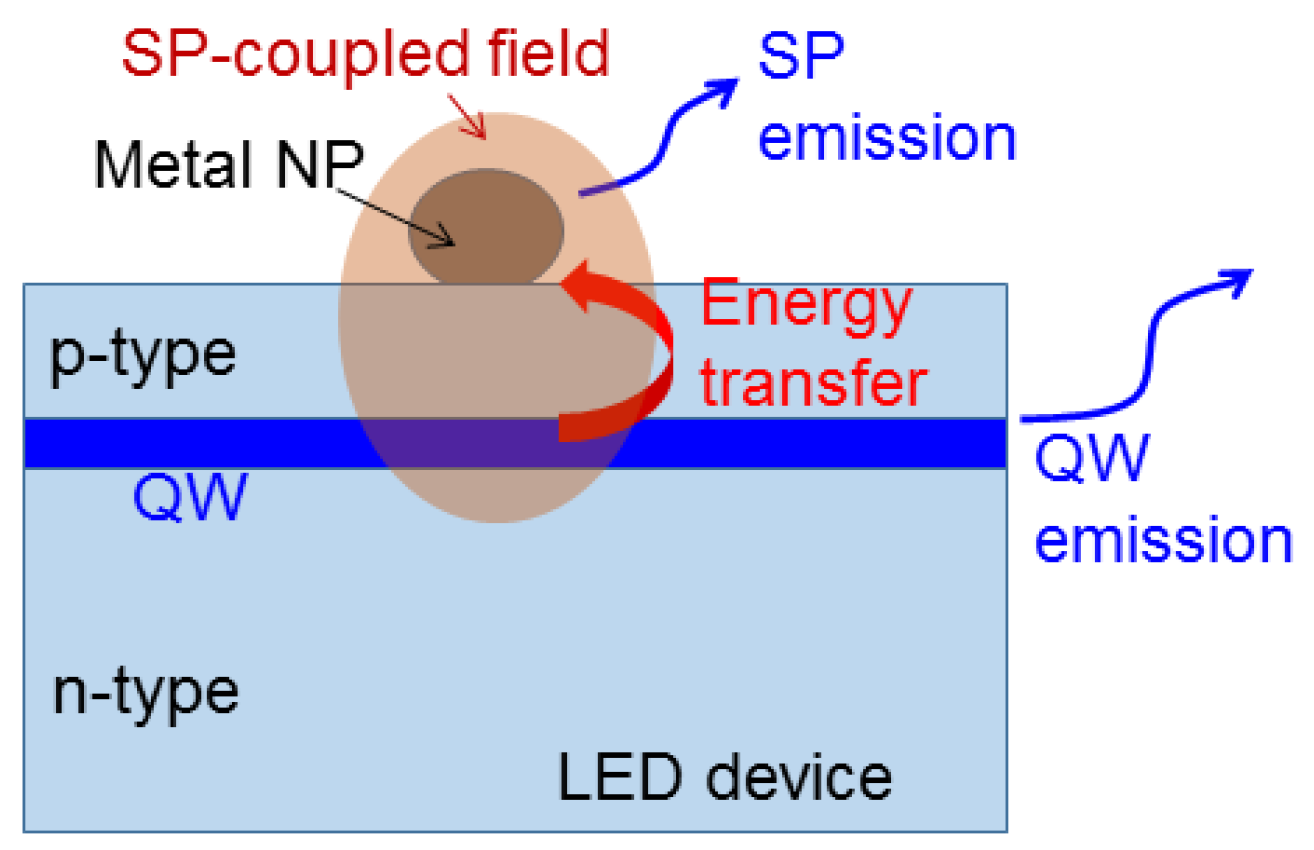



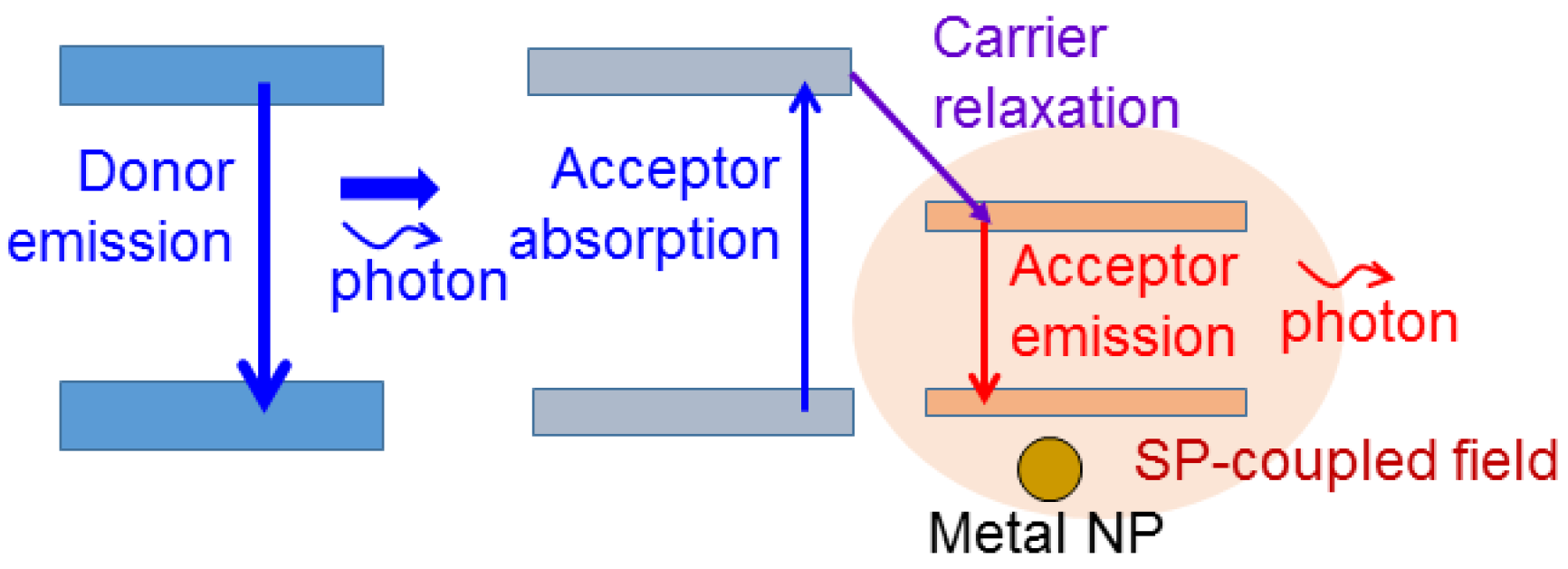

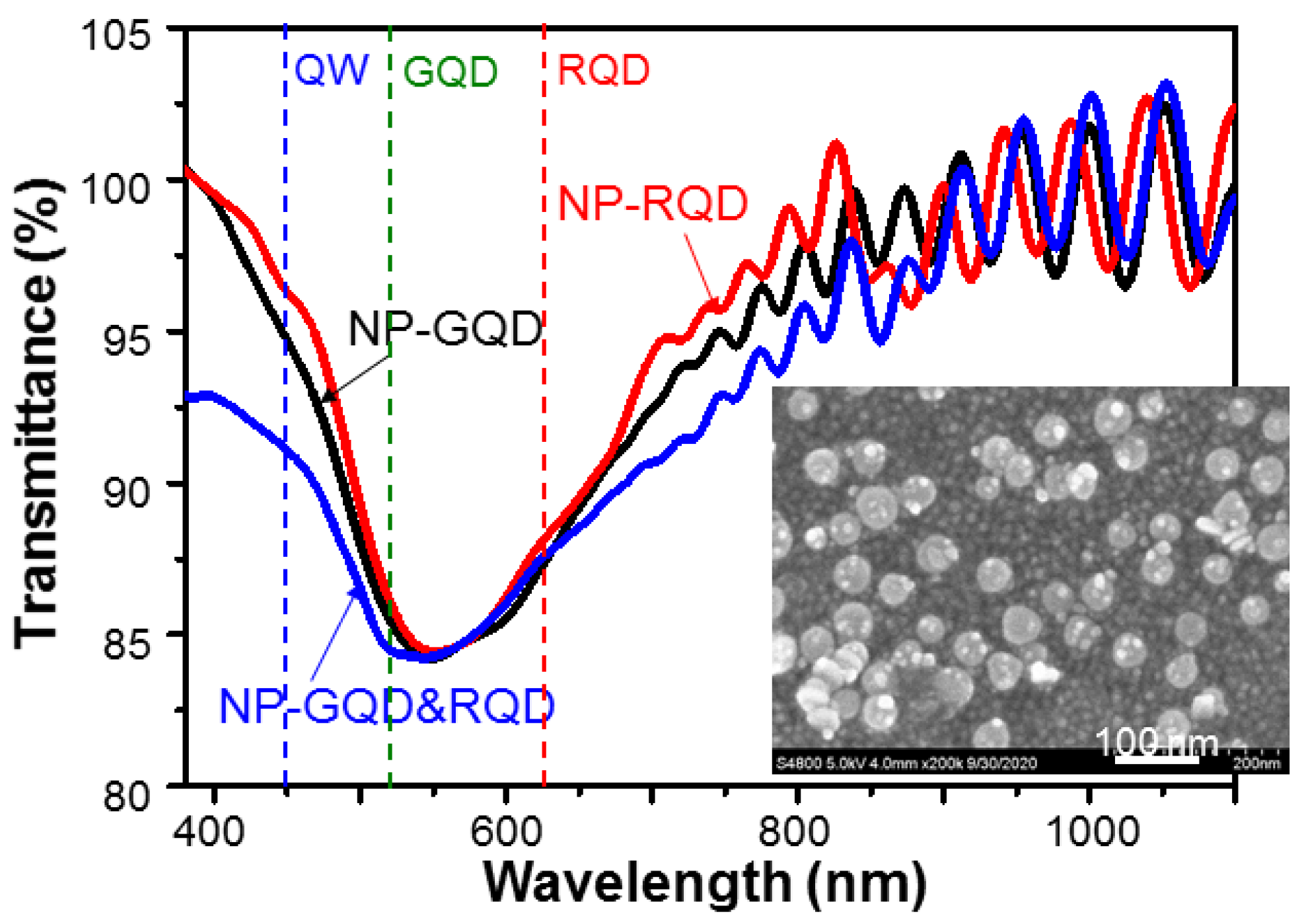
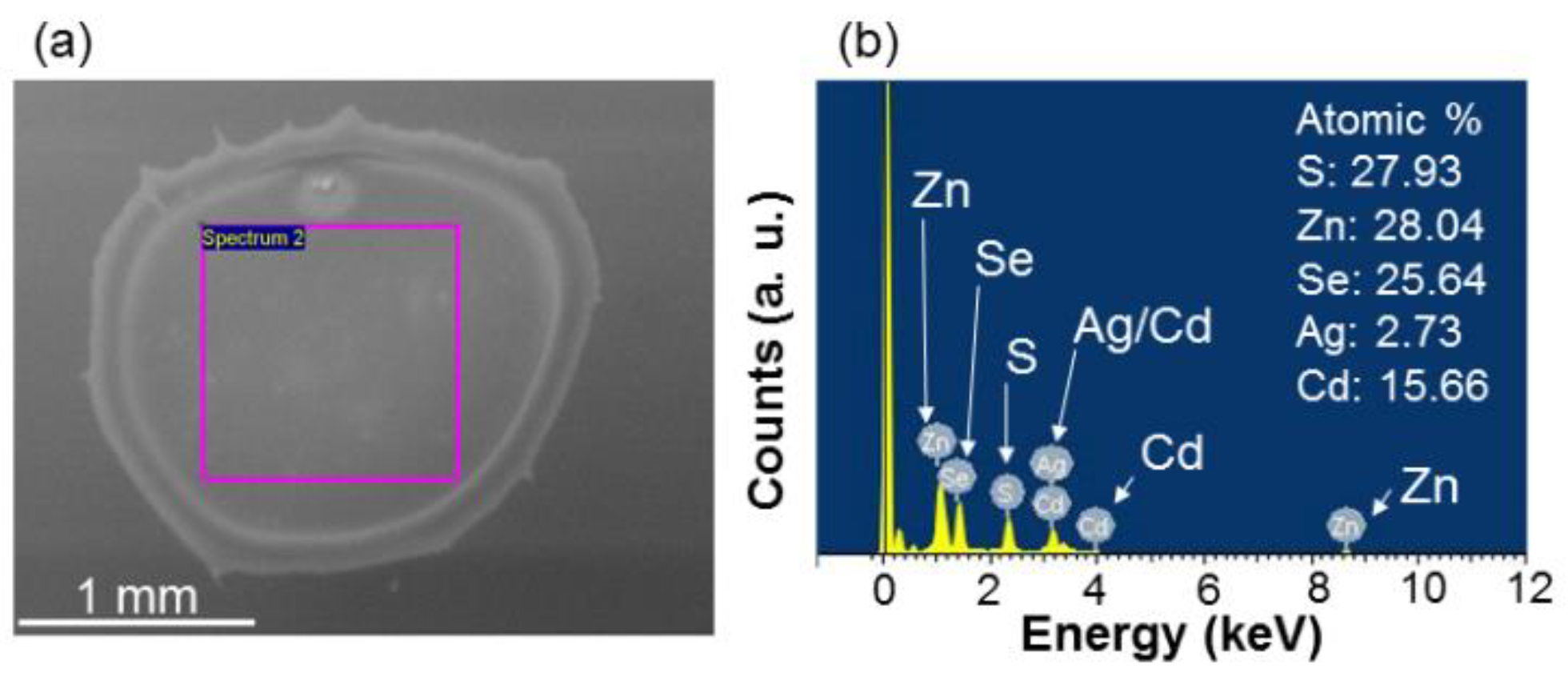
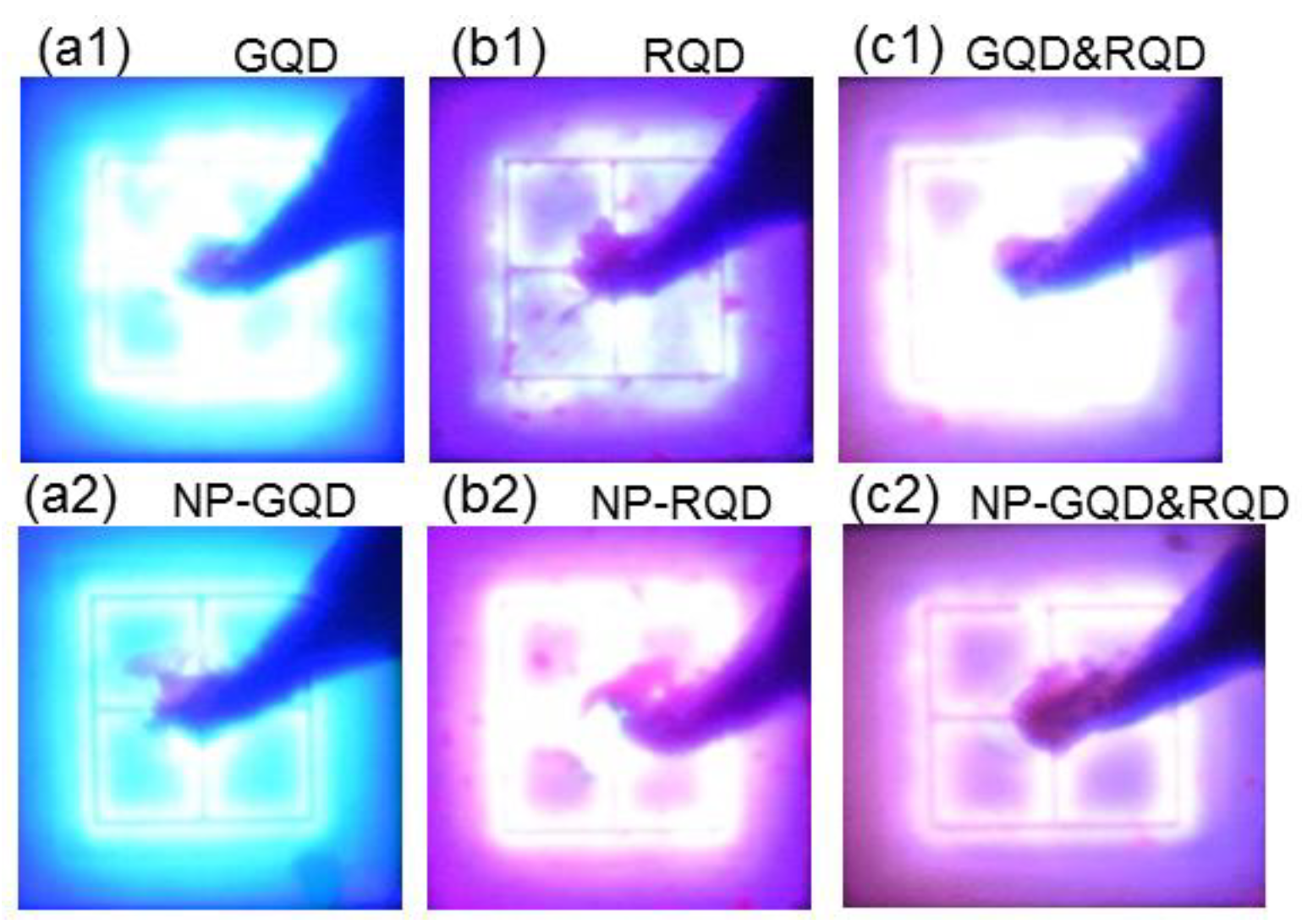
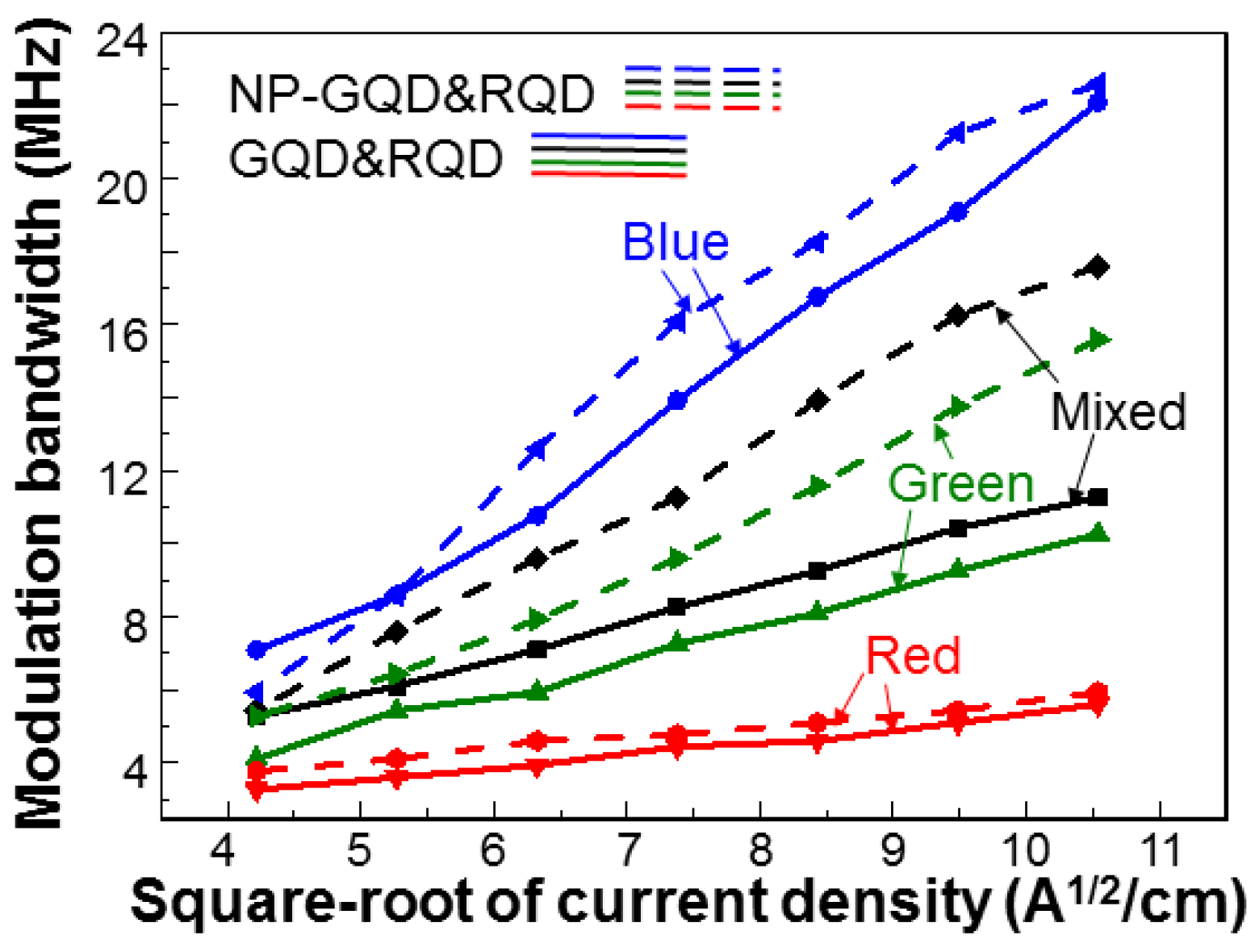
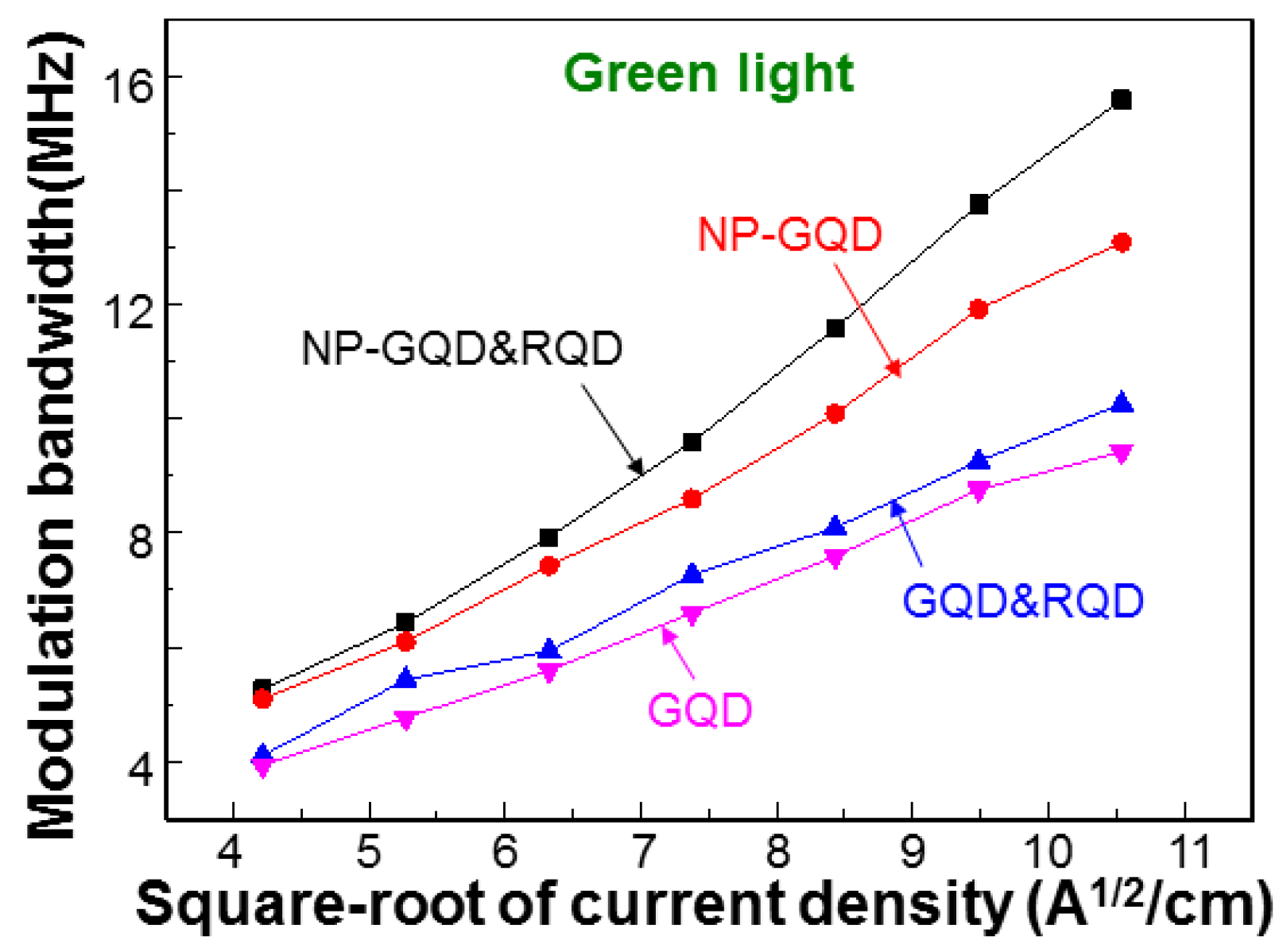
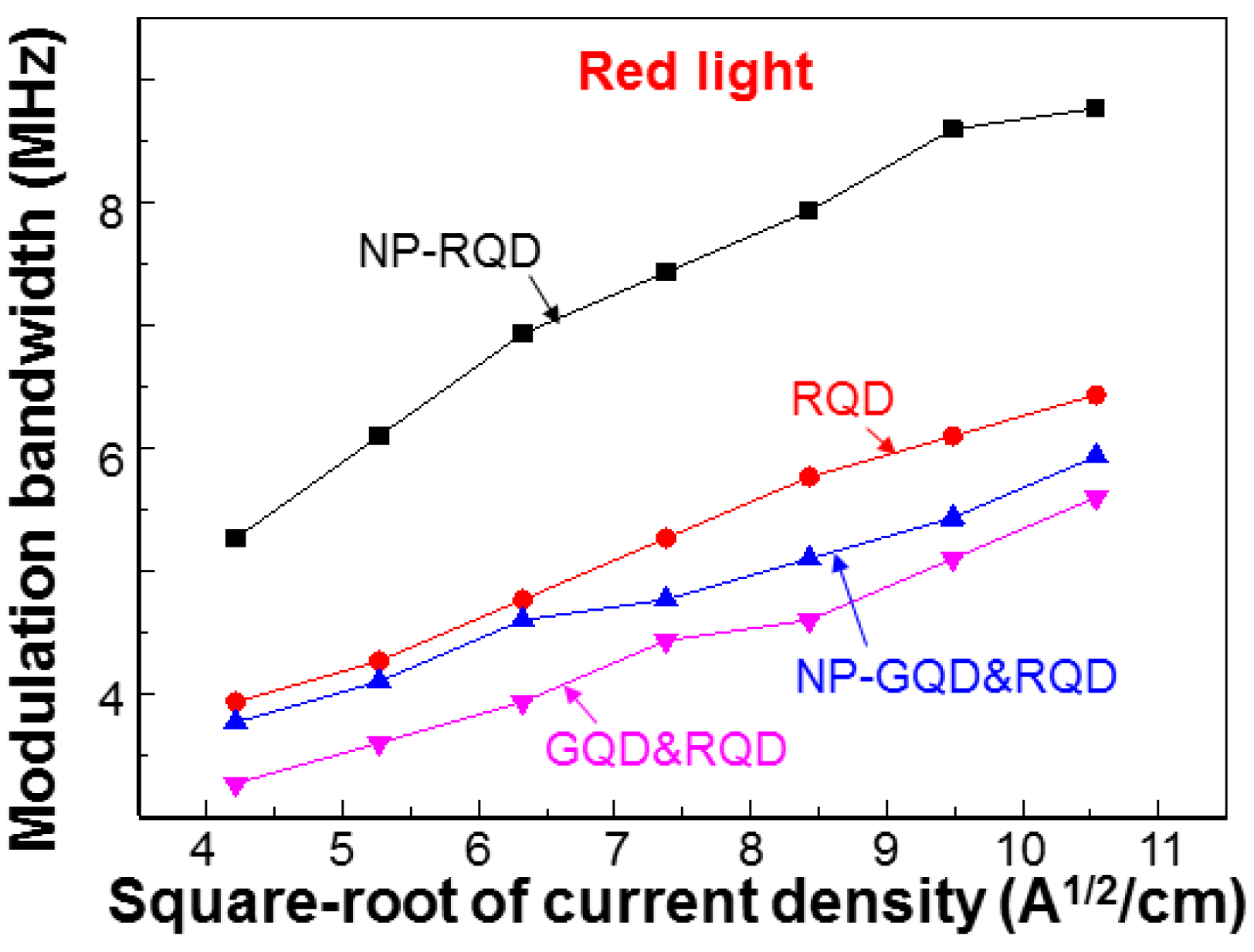
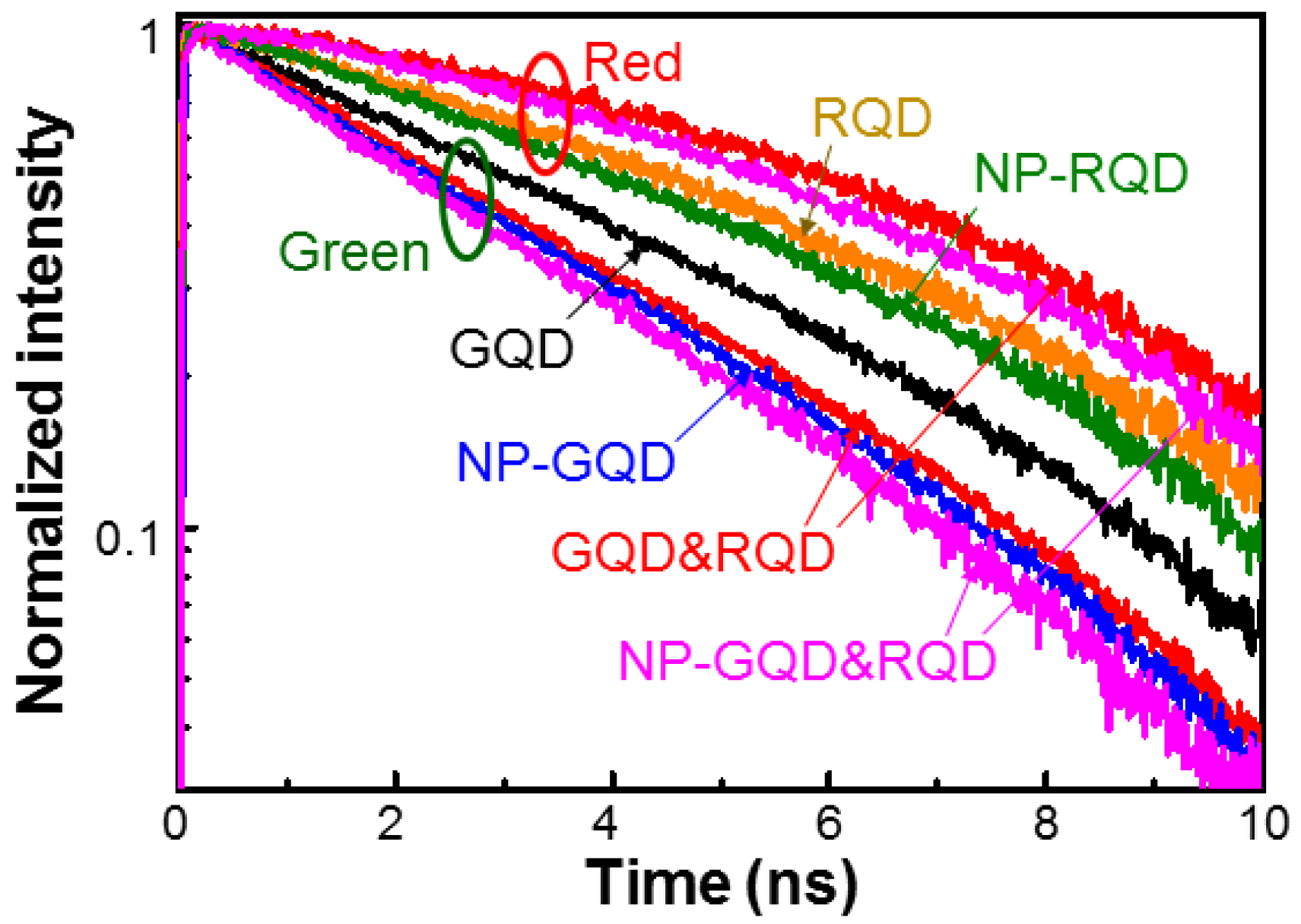
| Sample | Blue (MHz) | Green (MHz) | Red (MHz) | Mixed (MHz) |
|---|---|---|---|---|
| GQD | 21.75 (1) | 9.42 (1) | --- | 12.75 |
| RQD | 20.25 {1} | --- | 6.43 {1} | 11.09 |
| GQD&RQD | 22.08 (1.02) | 10.26 (1.09) | 5.59 {0.87} | 11.26 |
| NP-GQD | 22.74 (1.05) | 13.09 (1.39) | --- | 18.75 |
| NP-RQD | 22.91 {1.09} | --- | 8.76 {1.36} | 16.26 |
| NP-GQD&RQD | 22.58 (1.04) | 15.58 (1.65) | 5.93 {0.92} | 17.58 |
| Sample | Green PL Decay Time (ns) | Red PL Decay Time (ns) | FRET Efficiency (%) |
|---|---|---|---|
| GQD | 4.095 (1) | -- | -- |
| RQD | -- | 5.377 {1} | -- |
| GQD&RQD | 3.453 (1.09) | 6.505 {0.91} | 15.7 |
| NP-GQD | 3.291 (1.12) | -- | -- |
| NP-RQD | -- | 4.942 {1.04} | -- |
| NP-GQD&RQD | 3.095 (1.15) | 6.052 {0.94} | 6.0 |
Publisher’s Note: MDPI stays neutral with regard to jurisdictional claims in published maps and institutional affiliations. |
© 2022 by the authors. Licensee MDPI, Basel, Switzerland. This article is an open access article distributed under the terms and conditions of the Creative Commons Attribution (CC BY) license (https://creativecommons.org/licenses/by/4.0/).
Share and Cite
Yang, S.; Chen, P.-Y.; Ni, C.-C.; Chen, J.-C.; Li, Z.-H.; Kuo, Y.; Yang, C.-C.; Hsu, T.-C.; Lee, C.-L. Enhancement of the Modulation Response of Quantum-Dot-Based Down-Converted Light through Surface Plasmon Coupling. Molecules 2022, 27, 1957. https://doi.org/10.3390/molecules27061957
Yang S, Chen P-Y, Ni C-C, Chen J-C, Li Z-H, Kuo Y, Yang C-C, Hsu T-C, Lee C-L. Enhancement of the Modulation Response of Quantum-Dot-Based Down-Converted Light through Surface Plasmon Coupling. Molecules. 2022; 27(6):1957. https://doi.org/10.3390/molecules27061957
Chicago/Turabian StyleYang, Shaobo, Po-Yu Chen, Chia-Chun Ni, Jun-Chen Chen, Zong-Han Li, Yang Kuo, Chih-Chung Yang, Ta-Cheng Hsu, and Chi-Ling Lee. 2022. "Enhancement of the Modulation Response of Quantum-Dot-Based Down-Converted Light through Surface Plasmon Coupling" Molecules 27, no. 6: 1957. https://doi.org/10.3390/molecules27061957






